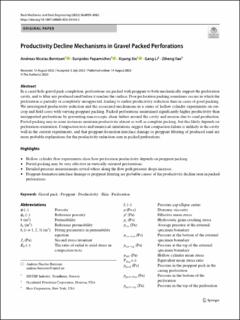| dc.contributor.author | Berntsen, Andreas Nicolas | |
| dc.contributor.author | Papamichos, Euripides | |
| dc.contributor.author | Xie, Xiyang | |
| dc.contributor.author | Li, Gang | |
| dc.contributor.author | Yao, Ziheng | |
| dc.date.accessioned | 2024-04-10T13:38:55Z | |
| dc.date.available | 2024-04-10T13:38:55Z | |
| dc.date.created | 2023-10-09T15:43:40Z | |
| dc.date.issued | 2023 | |
| dc.identifier.citation | Rock Mechanics and Rock Engineering. 2023, 56, 6959-6982. | en_US |
| dc.identifier.issn | 0723-2632 | |
| dc.identifier.uri | https://hdl.handle.net/11250/3125860 | |
| dc.description.abstract | In a cased hole gravel pack completion, perforations are packed with proppant to both mechanically support the perforation cavity, and to filter any produced sand before it reaches the surface. Poor perforation packing sometimes occurs in which the perforation is partially or completely unsupported, leading to earlier productivity reduction than in cases of good packing. We investigated productivity reduction and the associated mechanisms in a series of hollow cylinder experiments on outcrop and field cores with varying proppant packing. Packed perforations maintained significantly higher productivity than unsupported perforations by preventing macroscopic shear failure around the cavity and erosion due to sand production. Partial packing may in some instances maintain productivity almost as well as complete packing, but this likely depends on perforation orientation. Compaction tests and numerical simulations suggest that compaction failure is unlikely at the cavity wall in the current experiments, and that proppant-formation interface damage or proppant filtering of produced sand are more probable explanations for the productivity reduction seen in packed perforations. | en_US |
| dc.language.iso | eng | en_US |
| dc.publisher | Spinger Nature | en_US |
| dc.rights | Navngivelse 4.0 Internasjonal | * |
| dc.rights.uri | http://creativecommons.org/licenses/by/4.0/deed.no | * |
| dc.title | Productivity Decline Mechanisms in Gravel Packed Perforations | en_US |
| dc.title.alternative | Productivity Decline Mechanisms in Gravel Packed Perforations | en_US |
| dc.type | Peer reviewed | en_US |
| dc.type | Journal article | en_US |
| dc.description.version | publishedVersion | en_US |
| dc.rights.holder | © The Author(s) 2023. Published by Springer Nature. | en_US |
| dc.source.pagenumber | 6959-6982 | en_US |
| dc.source.volume | 56 | en_US |
| dc.source.journal | Rock Mechanics and Rock Engineering | en_US |
| dc.identifier.doi | 10.1007/s00603-023-03456-3 | |
| dc.identifier.cristin | 2183011 | |
| dc.relation.project | Norges forskningsråd: 268159 | en_US |
| cristin.ispublished | true | |
| cristin.fulltext | original | |
| cristin.qualitycode | 2 | |

